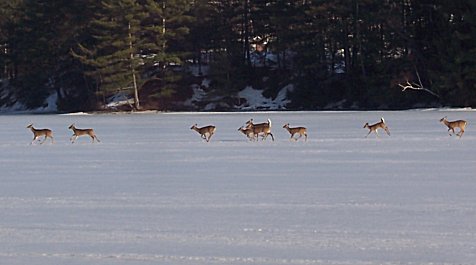Feeding deer does more harm than good

It has indeed been a tough winter on wildlife. Two weeks ago, a friend informed me that
she and other residents of Third Avenue, in Goffstown, had extensive damage done to their bushes by deer who were feeding on them. I interviewed Henry Metz, who said the number of deer he saw from his back porch windows at times was unreal. "I counted 15 deer crossing my land one day," he told me.
In interviewing Steve Ranfos, a retired Manchester police officer who lives on Third Avenue, he confirmed that there were some people were deliberately feeding deer in the area this winter. We took a hike up the ridge behind Metz’s and the Frechette residences. On the way up, we saw many piles of deer poop everywhere. Steve pointed to a shed well below us and said, "If you look just beyond that shed, you can see where the snow is sort of colored. The guy that owns that land has been feeding the deer all winter there. I’ve come up here and watched the deer feeding on his property. There were even young deer in groups feeding, but older deer would come on the feed site and kick them off." Perhaps the man thought feeding the deer would help protect peoples’ bushes and make finding food easier for the deer.

Whitetail
deer crossing Glen Lake, March 24, 2008
(Photo by Rebecca Caron)
Although feeding deer is not illegal, the Fish and Game Department specifically urges people not to feed deer and for a good reason.
Feeding deer often makes them more vulnerable to starvation, predation, disease and vehicle collisions, among other things. As Strafford, New Hampshire land-owner Harmony Anderson said, "I fed deer for one winter, but have since stopped because the bigger deer kicked at the smaller ones and chased them off. I know people care about deer, but wild animals are supposed to live on wild food. If deer depend on us for food, then they are no longer wild."
According to New Hampshire Fish and Game wildlife biologists, supplemental feeding can harm deer. Supplemental feed sites
congregate deer into unnaturally high densities. The high deer densities can attract predators and increase the risk of death by coyotes and domestic dogs. It can also spread diseases like tuberculosis (TB) and chronic wasting disease
(CWD) among the deer. It can cause aggression among the deer and waste their vital energy reserves, leading to
and even death. Feeding deer also reduces their fat reserves as deer use energy traveling to and from the feed site.
Supplemental feeding of deer also results in over-browsing of local vegetation and ornamental plants. It also denies access to food
because subordinate deer are kept away from feeding stations and over-browsing by larger deer and therefore removes food available to fawns. And finally, feeding deer increases the risk of deer-vehicle collisions at a number greater than those that would naturally succumb to winter mortality.
Feed sites cause deer to depend less on their natural environment and depend more on humans. The deer may lose their fear of humans and become habituated to feed sites. Deer receive little nutritional value from a new food source for about two weeks because rumen microorganisms must adjust to the diet change. While well-intentioned people try to help the deer by introducing
them to supplemental food, they may be harming them due to the time and energy needed to convert the microorganisms. The New Hampshire Fish and Game Department does not advocate the supplemental feeding of deer, will not participate in winter feeding efforts and urges land-owners not to feed deer.
According to New Hampshire wildlife biologists, white-tailed deer in New Hampshire and Maine, are at the northern limit of their range and have several natural adaptations that help them survive the winter. These include a thick winter coat of hollow hairs and the storage of fat in the fall for later use during winter. Adult deer lose up to 20 percent of their body weight during winter, regardless of the amount or quality of food present. Adult deer get as much as 40 percent of their daily energy during winter from their fat tissue.
During winter, cover, not forage, becomes the key to survival. Deer seek softwood cover (deer yards) to avoid deep snow, high winds and extreme cold. They use a network of trails collectively created to help reduce energy expenditure and escape predators. Wintering deer tend to disperse over an area large enough to reduce competion for food and risk of predation if adequate cover exists.
Despite these adoptions, some deer will die in winter. This occurs more commonly in older or smaller deer, especially among those with fewer fat reserves. If winter ends before the fat reserves are expended, the deer survives. If fat reserves are gone before the end of winter, the deer dies. Therefore, any activity that increases energy use can actually lead to the death of individual deer and reduce the population.
How can you help deer? For the long-term health of deer, Fish and Game says that the best management strategy is to keep deer dependent on their natural food and cover. By feeding the deer in winter, it is not helping them. A healthy deer population will be sustained if New Hampshire maintains mature softwood wintering areas, young hardwood stands, nut producing trees such as oak and beech, and forest openings.
Next week, I will delve into how land-owners can protect their shrubs, etc., from having deer eat them during the rough winter months as they have done to Third Avenue Goffstown residents.

Bob Harris can be
reached via e-mail at:
outwriter2@aol.com
Past
Columns by Bob Harris
>>>
About
Bob Harris
>>>
DISCLAIMER: The opinions
expressed by Mr. Harris are not necessarily those of the
Goffstown Residents Association or its members
Copyright©2010 Goffstown Residents Association. All Rights Reserved. |





